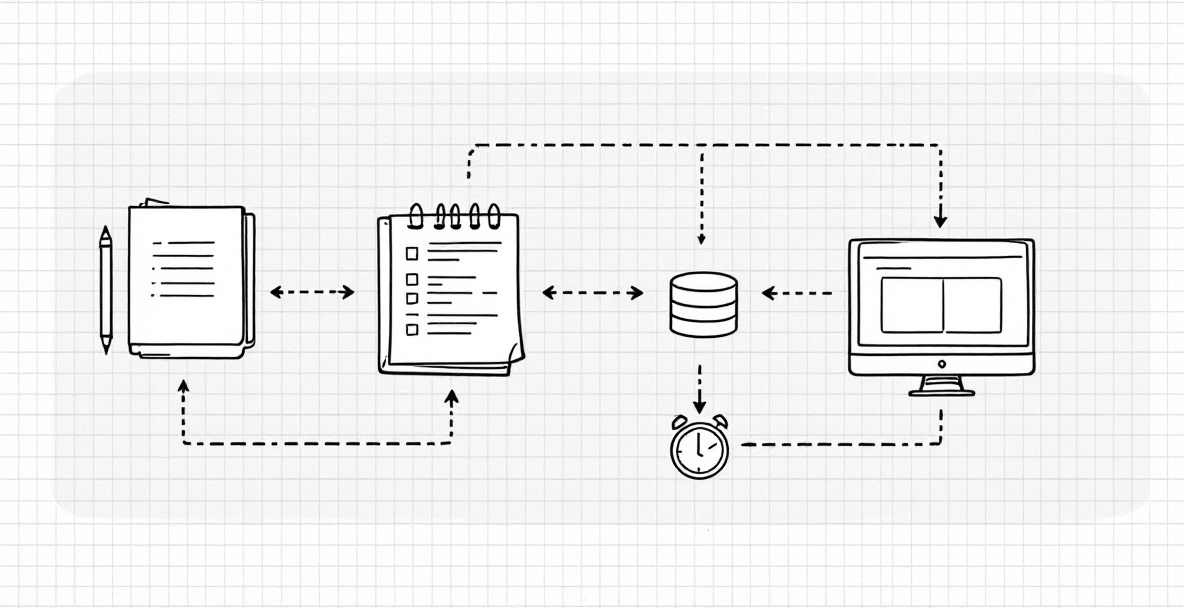In today's content-driven digital world, the difference between brands that thrive and those that struggle often comes down to one critical factor: consistency. Publishing high-quality content day after day requires tremendous resources—time, skilled personnel, and creative energy that many businesses simply don't have. This perpetual content treadmill leaves marketers and content creators exhausted, yet the demands of audience engagement and search engine algorithms continue relentlessly. Fortunately, automated blog publishing systems have emerged as a game-changing solution, allowing brands to maintain a consistent content presence without the traditional manual publishing grind.
The Content Struggle: Why Manual Publishing Isn't Cutting It Anymore

The traditional approach to content creation—researching, writing, editing, formatting, publishing, and promoting each piece individually—has become increasingly unsustainable for businesses seeking to maintain relevance in today's fast-paced digital environment. As content consumption patterns evolve and attention spans shrink, the demand for fresh, relevant content has skyrocketed, creating an almost impossible standard for teams relying on purely manual workflows.
Even the most dedicated content teams find themselves overwhelmed by the sheer volume required to maintain visibility across multiple platforms. The expectation has shifted from publishing weekly or monthly to an almost constant stream of content that keeps audiences engaged and algorithms satisfied. This new reality requires a fundamental rethinking of how content is produced and distributed.
The Real Cost of Manual Content Management
The hidden costs of manual content management extend far beyond the obvious time investment. When calculating the true expense of traditional publishing methods, we must consider the complete workflow: planning meetings, research time, drafting, multiple revision rounds, formatting, uploading, optimizing for SEO, creating accompanying visuals, and coordinating distribution across channels.
For a single high-quality blog post, this process often consumes 10-15 hours of combined team effort. Multiply this by several posts weekly, and the resource drain becomes staggering. Beyond the direct labor costs, there's the opportunity cost—what could your team accomplish if they weren't caught in this perpetual content creation cycle? Strategic thinking, audience relationship building, and innovation often take a backseat to the pressing demands of feeding the content machine.
The manual approach also introduces inconsistency. Quality and publishing schedules fluctuate based on team availability, creative energy levels, and competing priorities. These inconsistencies can undermine audience trust and harm search rankings, effectively nullifying the benefits the content was meant to deliver in the first place.
The Automation Revolution in Content Publishing
The shift toward automation represents more than just a technological evolution—it's a fundamental reimagining of the content production process. Automated publishing systems have transformed what was once a labor-intensive, linear workflow into a scalable, consistent engine that can operate around the clock.
This revolution has been enabled by advances in artificial intelligence, workflow management tools, and integration capabilities that allow different platforms to communicate seamlessly. Modern automation solutions don't simply schedule pre-written content—they can assist with or handle entirely multiple stages of the content lifecycle, from topic generation and research to distribution and performance analysis.
What makes this approach revolutionary is how it changes the role of human content creators. Rather than eliminating the need for human input, automation elevates it. Content teams can shift from production-line work to higher-value activities: developing content strategy, refining brand voice, and making creative decisions that genuinely require human judgment. The result is not just more content, but often better content delivered more consistently.
Understanding Automated Blog Publishing Systems: The Core Components

Creating a truly effective automated publishing system requires more than just adopting a single tool or platform. It involves building an ecosystem of complementary technologies that work together to streamline every aspect of content creation and distribution. Understanding these core components is essential for implementing a system that delivers real value rather than just adding technological complexity.
At SeoFlow, we've spent years refining our understanding of what makes an automated content system truly effective. The ideal solution combines powerful AI content generation capabilities with sophisticated workflow management and distribution tools, all united by seamless integrations that eliminate manual handoffs between stages.
Content Planning and Scheduling Tools
The foundation of any automated publishing system is effective content planning and scheduling. These tools transform what was once a chaotic, reactive process into a structured, proactive strategy. Modern content planning platforms allow teams to visualize their entire content calendar, identify gaps or oversaturation, and ensure content aligns with broader marketing initiatives and seasonal opportunities.
Advanced scheduling tools extend beyond basic calendaring functions to incorporate intelligent timing optimization. These systems can analyze audience engagement patterns to identify ideal publishing windows for maximum impact. For example, SeoFlow's scheduling engine can automatically determine the optimal posting times based on historical performance data, ensuring content reaches audiences when they're most receptive.
The most powerful planning tools also incorporate collaborative features that streamline the approval process. Rather than endless email chains and confused versioning, stakeholders can provide feedback directly within the platform, maintaining a clear record of decisions and changes while automating notification and reminder systems.
Content Management Systems and Integration
While content management systems (CMS) have been around for decades, their role within automated publishing frameworks has evolved significantly. Today's CMS platforms serve as central hubs that connect with other specialized tools through APIs and dedicated integrations, creating a cohesive ecosystem rather than a standalone publishing platform.
This integration capability is what transforms a basic CMS into a core component of automation. When your CMS can seamlessly communicate with your content creation tools, analytics platforms, social media schedulers, and email marketing systems, the traditional boundaries between these functions disappear. Content can flow automatically from creation to publication to promotion without manual intervention at each transition point.
For businesses seeking true automation, the ability of different platforms to "talk" to each other is non-negotiable. At SeoFlow, we prioritized building robust integrations with popular platforms like WordPress, Ghost, and Notion, ensuring our AI-generated content can seamlessly move into your existing publishing ecosystem without creating new workflow bottlenecks.
Analytics and Performance Tracking
The final essential component of automated blog publishing is sophisticated analytics that closes the feedback loop. Automated content systems generate valuable data at every stage, and capturing this information unlocks continuous improvement opportunities that manual processes simply cannot match.
Modern analytics tools provide much more than basic page views or social shares. They can track user engagement patterns, content consumption behaviors, conversion paths, and attribution across multiple touchpoints. When integrated directly into your publishing system, these insights can automatically influence future content creation and distribution decisions.
For example, SeoFlow's analytics engine tracks which topics, formats, and distribution channels deliver the strongest performance, then automatically adjusts content recommendations and scheduling to amplify what's working. This creates a self-optimizing system that grows more effective over time without requiring manual analysis and adjustment.
Building Your Content Publishing Automation Solution

Implementing an automated content system requires thoughtful planning and strategic decision-making. The goal isn't just to add technology—it's to create a seamless workflow that minimizes friction while maximizing content quality and consistency. Building your solution involves three critical phases: tool selection, workflow design, and quality control implementation.
Selecting the Right Tools and Platforms
The foundation of your automated publishing system lies in choosing tools that align with your specific needs, goals, and existing technology stack. This isn't about finding the most feature-rich platforms, but rather identifying solutions that solve your particular content challenges and work well together.
Start by auditing your current content processes to identify the most significant bottlenecks and pain points. Is content creation your biggest challenge? Focus on AI content generation tools like SeoFlow that can produce high-quality draft content at scale. Are you struggling with consistency in publishing schedules? Prioritize robust scheduling and workflow management capabilities. Does your team waste time manually distributing content across multiple channels? Look for solutions with strong multi-platform publishing features.
Integration capabilities should be a primary consideration rather than an afterthought. Even the most powerful tools become productivity drains if they create new manual steps. Before committing to any platform, verify that it can connect with your existing systems through native integrations, APIs, or third-party connectors like Zapier. The most efficient automated systems are those where content flows seamlessly between tools without human intervention.
Finally, consider scalability and future needs. The solutions that work for your current volume may become limiting as your content operation grows. Choose platforms with tiered pricing models and enterprise capabilities that can accommodate your future ambitions without requiring a complete system overhaul.
Creating Content Workflows and Templates
With your tools selected, the next step is designing streamlined workflows that minimize decision fatigue and manual intervention. Effective content automation isn't about removing human oversight entirely—it's about ensuring human effort focuses on high-value decisions while routine tasks happen automatically.
Begin by mapping your ideal content journey from conception to distribution and beyond. Identify every decision point, handoff, and action required. Then, determine which of these steps genuinely require human judgment and which can be automated or template-driven. For instance, topic selection might need human strategic input, while formatting for different platforms can be fully automated.
Templates play a crucial role in maintaining quality and consistency while accelerating production. Develop standardized structures for different content types—how-to guides, listicles, case studies, news updates—that incorporate your brand voice guidelines and content best practices. These templates serve as blueprints that ensure content maintains a consistent quality standard regardless of who (or what) created the initial draft.
At SeoFlow, we've found that customizable AI templates dramatically improve content quality and brand alignment. Our platform allows users to define specific parameters for tone, style, and structure that the AI consistently applies, ensuring all automated content feels authentically aligned with the brand voice rather than generically algorithmic.
Setting Up Quality Control Checkpoints
No matter how sophisticated your automation becomes, quality control remains essential. The most effective automated systems incorporate strategic human oversight at key points in the workflow, focusing human attention where it adds the most value.
Establish clear quality criteria for different content types and create specific checkpoints where content must meet these standards before proceeding to the next stage. These checkpoints might include reviewing AI-generated drafts for factual accuracy, ensuring brand messaging alignment, or verifying that SEO elements have been properly implemented.
Automation can actually enhance quality control by standardizing the review process. Create checklists that reviewers follow for different content types, ensuring consistent evaluation regardless of who performs the review. Over time, this consistency creates valuable data about common issues that can be addressed systematically, further improving your content creation processes.
For organizations concerned about brand reputation, implementing graduated approval workflows offers peace of mind. Junior team members can handle initial reviews, with more sensitive or high-stakes content requiring additional approval from senior stakeholders. These approvals can be built directly into your workflow, with automatic notifications and tracking to prevent bottlenecks.
Maximizing Your Automated System's Potential

Once your automated publishing system is operational, the focus shifts to optimization and expansion. This is where the true power of automation becomes apparent—in its ability to not just maintain but continuously improve content performance while scaling your output across channels and formats.
Content Repurposing and Cross-Platform Publishing
One of the most significant advantages of automated content systems is their ability to efficiently transform a single piece of content into multiple formats tailored for different platforms and audiences. This multiplies your content's reach and impact without proportionally increasing creation time.
Modern automation tools can take a comprehensive blog post and automatically extract the most compelling segments for social media, create summary versions for email newsletters, or transform key points into visually appealing infographics. This repurposing happens systematically rather than as an afterthought, ensuring your content investment generates maximum returns across all your channels.
Cross-platform publishing automation ensures content reaches audiences wherever they prefer to engage, with formatting and presentation optimized for each destination. For example, SeoFlow can automatically adjust content length, formatting, and calls-to-action based on whether the piece is destined for your blog, Medium, LinkedIn, or an email newsletter, eliminating the manual reformatting that typically makes multi-platform publishing so time-consuming.
The most sophisticated systems also consider timing variations across platforms, scheduling content distribution to align with optimal engagement times for each channel rather than publishing everywhere simultaneously. This staggered approach maximizes visibility while creating multiple opportunities for audience interaction.
Automated SEO Optimization
Search visibility remains a critical component of content success, but manual SEO optimization is time-consuming and often inconsistently applied. Automated publishing systems can build SEO best practices directly into the content creation process, ensuring every piece is optimized from conception rather than retrofitted later.
Advanced systems like SeoFlow incorporate real-time competitive analysis, automatically evaluating top-ranking content for your target keywords and identifying gaps or opportunities your content can address. This data-driven approach ensures your content strategy targets valuable search opportunities rather than saturated topics where ranking would be difficult.
Automation excels at technical SEO elements that are crucial but easily overlooked in manual workflows: proper heading structure, image alt text, internal linking, metadata optimization, and keyword distribution. By systematizing these elements, every piece maintains SEO best practices regardless of who created it or how quickly it was produced.
Most importantly, automated SEO isn't static—it evolves with search algorithms and performance data. As your content accumulates performance history, the system can identify which SEO approaches are delivering results for your specific audience and content types, then automatically apply these insights to future content.
Performance Monitoring and Optimization
The true power of automation extends beyond initial publication to creating a continuous improvement cycle. Automated performance monitoring connects content metrics directly to your creation and distribution workflow, allowing data-driven optimization without manual analysis.
Set up automated tracking for key performance indicators relevant to your content goals: traffic metrics, engagement rates, conversion statistics, and audience growth. The most effective systems aggregate this data automatically and translate it into actionable insights rather than raw numbers requiring interpretation.
Automated A/B testing can systematically explore variables that impact performance: headline variations, content structures, call-to-action placements, or distribution timing. Unlike manual testing, automated systems can run these experiments consistently across your entire content program, rapidly accumulating statistically significant results that drive ongoing optimization.
The ultimate goal is creating a self-improving system where performance insights automatically influence future content decisions. For example, SeoFlow's AI engine learns from content performance, gradually refining its understanding of what resonates with your specific audience and adjusting its content generation accordingly.
Taking Your Content Machine to the Next Level
Transforming your content operation from a manual, resource-intensive process to an efficient automated system represents a significant competitive advantage in today's content-saturated landscape. By implementing the right technology stack and workflows, you can dramatically increase both the quantity and quality of your content while freeing your team to focus on strategy and creativity.
Getting Started Checklist
If you're ready to build your automated blog publishing system, this structured approach will help ensure success:
First, audit your current content process to identify major bottlenecks and inefficiencies. Document the full journey from idea to publication and promotion, noting time investments at each stage and areas where quality or consistency suffers. This baseline understanding is essential for measuring improvement and prioritizing automation efforts.
Next, define clear objectives for your automated system beyond simply "more content." Are you seeking to improve publication consistency? Expand to new channels? Enhance content quality? Reduce team burnout? These goals will guide your technology and workflow decisions.
Evaluate potential technology solutions against your specific needs rather than generic feature lists. Prioritize platforms that offer robust integration capabilities with your existing tools, particularly your content management system and distribution channels. Modern CMS platforms are increasingly leveraging AI to streamline publishing workflows for news and media organizations, making integration capabilities crucial for future-proofing your system.
Start with a limited implementation focusing on automating your most problematic or time-consuming processes rather than attempting a complete system transformation immediately. This phased approach allows your team to adapt gradually while delivering quick wins that build momentum for broader changes.
Finally, establish clear metrics to measure system performance from the beginning. Track not just content output but quality indicators, team time savings, audience engagement improvements, and ultimately business impact measures like lead generation or revenue influence.
Future-Proofing Your Content Strategy
As you implement your automated publishing system, keep these forward-looking principles in mind to ensure your approach remains effective as technology and market conditions evolve:
Build flexibility into your automation architecture rather than rigid workflows that cannot adapt to changing needs. Choose platforms with robust APIs and integration capabilities that can accommodate new tools as they emerge. SeoFlow's open architecture allows it to connect with virtually any content platform through direct integrations or middleware solutions.
Continuously refine your balance between automation and human creativity. The most successful content operations leverage automation for routine tasks and data-driven decisions while preserving human oversight for strategic direction and creative flourishes that distinguish your brand voice. An introduction to automated blogging systems can help you understand this balance and set realistic expectations for what automation can achieve.
Invest in upskilling your team to work effectively within an automated environment. The roles of content creators evolve significantly when basic production is automated—team members need to develop higher-level skills in content strategy, performance analysis, and creative direction to provide maximum value. Expert advice on overcoming content automation challenges suggests that proper training and change management are often more critical to success than the technology itself.
Finally, maintain a testing mindset that continuously explores how automation can further improve your content operation. Regular experimentation with new capabilities, workflows, and optimizations prevents your system from stagnating and ensures you capitalize on emerging opportunities before competitors.
By embracing automated publishing with a thoughtful, strategic approach, you can transform content from a perpetual struggle into a sustainable competitive advantage that delivers consistent value to both your audience and your business.
Ready to transform your content creation process and build your own 24/7 content machine? Start your journey to content automation today with SeoFlow and discover




